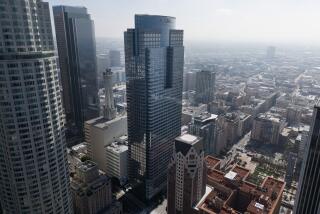Smokestack in Sad Shape, Officials in Del Mar Told
DEL MAR â The historic powerhouse, a beachfront building that housed generators that supplied electricity to the old Del Mar Hotel and part of the town in the 1920s, is structurally sound but the towering smokestack beside it is in sorry shape, an engineer has told city officials.
A full report from the firm conducting a $15,000 structural engineering study of the plant is expected by Monday. A decision on whether to restore the property will be made after public hearings and a poll are conducted to determine how city residents feel the building should be used.
City Manager Bob Nelson said that the smokestack--the cityâs only high-rise structure--has succumbed to 60 years of weather, shedding part of its protective concrete coating, revealing rusting patches of steel.
Once rust takes hold, Nelson said, âit spreads up and down the metal, not just at the exposed parts.â Although the engineer will outline what is necessary to repair the stack, Nelson said that the cost probably would dictate tearing down the 60-foot chimney.
How much it will cost to bring the two-story building and towering smokestack up to city building codes will be estimated in the report, said city planner Dan Rehm, but the price of making the facility operable again will not be estimated.
Nelson said that tearing down the smokestack may bring negative reaction from the Navy because the beachfront beacon on it is one of three landmarks used to calibrate shipboard instruments as vessels head out to sea from San Diego. The other two are the Encina power plant smokestack in Carlsbad and a target on the Torrey Pines Golf Course.
Connie Geritz, chairwoman of a citizensâ committee studying future uses for the powerhouse building, said that the engineering report will be the basis for a poll in the cityâs November newsletter. A recommendation by the committee is expected early next year.
The powerhouse was the second structure built to provide power for the Stratford Inn, which was built in 1908 and later renamed the Del Mar Hotel. The first power station--a squat, ugly brick structure with a short smokestack--was torn down after the present building was erected in the mid-1920s.
In 1936, the powerhouse was shut down when San Diego Gas & Electric Co. began providing electricity to the entire Del Mar community. In the 1950s, the building became a nightclub featuring jazz bands, and the towering smokestack became a vertical sign advertising the âRoaring â20sâ night spot.
In the 1960s, the powerhouse was leased by a research firm, Universal Water Co., where scientists designed reverse osmosis techniques for converting seawater into drinking water.
In 1977, Robert King purchased the one-acre oceanfront property and planned to convert the powerhouse into a swank restaurant. But opposition from city residents put his plans on hold. Negotiations between King and the city resulted in a compromise that would have allowed the developer to open his restaurant but would have given the city title to the 200-foot-wide ocean frontage for park land. The deal fell through and the issue was headed to the courts when King agreed to sell the property to the city.
In February, 1983, residents voted resoundingly to buy the powerhouse property for $800,000. Since then, the debate has centered on whether the powerhouse can be revamped and to what use it should be put.
The Del Mar Foundation, a nonprofit organization that raises funds for community purposes, will head fund raising for renovation after the buildingâs use is decided, according to Geritz.
More to Read
Sign up for Essential California
The most important California stories and recommendations in your inbox every morning.
You may occasionally receive promotional content from the Los Angeles Times.










